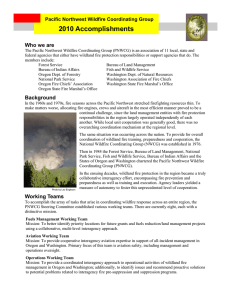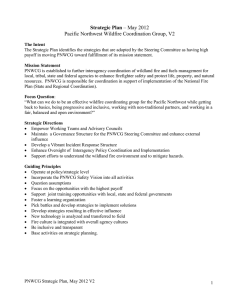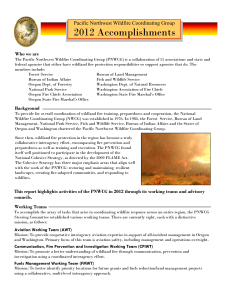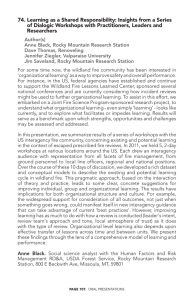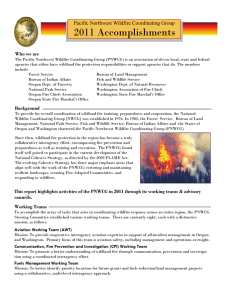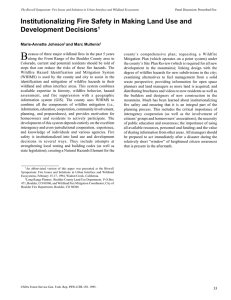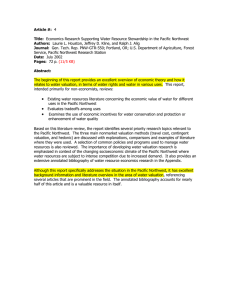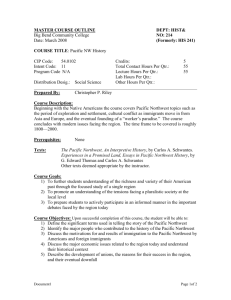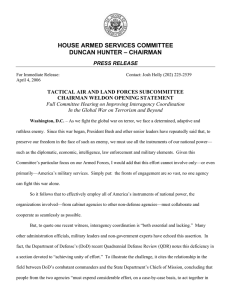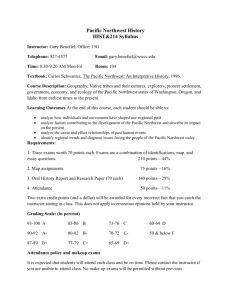2013 Accomplishments Pacific Northwest Wildfire Coordinating Group Who we are
advertisement
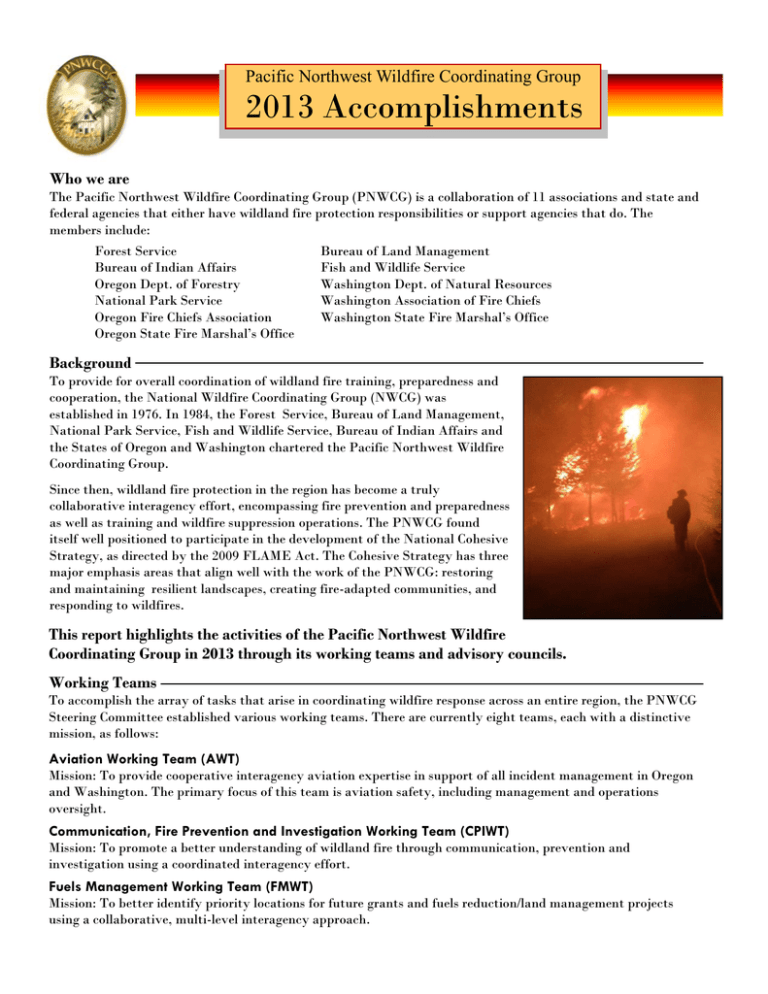
Pacific Northwest Wildfire Coordinating Group 2013 Accomplishments Who we are The Pacific Northwest Wildfire Coordinating Group (PNWCG) is a collaboration of 11 associations and state and federal agencies that either have wildland fire protection responsibilities or support agencies that do. The members include: Forest Service Bureau of Indian Affairs Oregon Dept. of Forestry National Park Service Oregon Fire Chiefs Association Oregon State Fire Marshal’s Office Bureau of Land Management Fish and Wildlife Service Washington Dept. of Natural Resources Washington Association of Fire Chiefs Washington State Fire Marshal’s Office Background To provide for overall coordination of wildland fire training, preparedness and cooperation, the National Wildfire Coordinating Group (NWCG) was established in 1976. In 1984, the Forest Service, Bureau of Land Management, National Park Service, Fish and Wildlife Service, Bureau of Indian Affairs and the States of Oregon and Washington chartered the Pacific Northwest Wildfire Coordinating Group. Since then, wildland fire protection in the region has become a truly collaborative interagency effort, encompassing fire prevention and preparedness as well as training and wildfire suppression operations. The PNWCG found itself well positioned to participate in the development of the National Cohesive Strategy, as directed by the 2009 FLAME Act. The Cohesive Strategy has three major emphasis areas that align well with the work of the PNWCG: restoring and maintaining resilient landscapes, creating fire-adapted communities, and responding to wildfires. This report highlights the activities of the Pacific Northwest Wildfire Coordinating Group in 2013 through its working teams and advisory councils. Working Teams To accomplish the array of tasks that arise in coordinating wildfire response across an entire region, the PNWCG Steering Committee established various working teams. There are currently eight teams, each with a distinctive mission, as follows: Aviation Working Team (AWT) Mission: To provide cooperative interagency aviation expertise in support of all incident management in Oregon and Washington. The primary focus of this team is aviation safety, including management and operations oversight. Communication, Fire Prevention and Investigation Working Team (CPIWT) Mission: To promote a better understanding of wildland fire through communication, prevention and investigation using a coordinated interagency effort. Fuels Management Working Team (FMWT) Mission: To better identify priority locations for future grants and fuels reduction/land management projects using a collaborative, multi-level interagency approach. Pacific Northwest Wildfire Coordinating Group 2013 Accomplishments Geographic Information Systems Working Team (GISWT) Mission: To provide efficient and effective ways to meet fire program needs for geospatial information through an interagency forum, and to develop a process for coordination of interagency-sponsored geospatial information initiatives. The GIS Working Team will work to support and implement strategic and tactical applications of GIS for the Pacific Northwest wildland fire community. Incident Business Practices Working Team (IBPWT) Mission: To provide an efficient, effective, coordinated interagency approach to the fire business management activities of wildland fire protection agencies in Oregon and Washington. Operations Working Team (OWT) Mission: To provide a coordinated interagency approach to operational activities of wildland fire management in Oregon and Washington; additionally, to identify issues and recommend proactive solutions to potential problems related to interagency fire pre-suppression and suppression programs. Safety and Health Working Team (SHWT) Mission: To improve firefighter health, safety and effectiveness through emphasis on excellence in workforce development, leadership and the establishment of standards based on principles within a developing safety culture. Through data collection and analysis the team will validate and prioritize safety issues for resolution and communication to the field and management. Training Working Team (TWT) Mission: To provide a coordinated, interagency approach to fire management training in the Pacific Northwest geographic area. Advisory Councils In 2013, the advisory councils were reduced from four to two. The Fire Environment Analysis Advisory Council disbanded, with the lead responsibility for its work given to the Predictive Services Unit Leader at the Northwest Interagency Coordination Center (NWCC). The Fire Program Analysis Advisory Council also disbanded in December. Now, two Inside Story Headline advisory councils provide advice to the PNWCG: Incident Commander Advisory Council Northwest Center Managers Advisory Council Incident Commander Advisory Council (ICAC) Mission: To serve the PNWCG as a body of resident experts, providing advice, and developing recommendations, processes and procedures to improve the consistency and performance of geographic area Interagency Incident Management Team (IIMT) operations. Northwest Center Managers Advisory Council (CMAC) Mission: To develop a formal interagency structure that would provide consistent oversight and organization to matters concerning the governance and operation of the Interagency Dispatch Coordination System. 2 Pacific Northwest Wildfire Coordinating Group 2013 Accomplishments What We Accomplished Here are some of the key accomplishments of the Steering Committee in 2013: Working with the OWT and the Washington and Oregon Interagency Incident Management Team (IIMT) governing boards, the Steering Committee refined direction for governance of Interagency Type 1 and Type 2 IIMTs. The Steering Committee met with six contractor associations in November and plans to do this on an annual basis. Through the CPIWT, produced the 2012 annual Accomplishment Report. PNWCG clearly communicated its sponsorship of the Interagency Fire Crew Agreement, which is implemented by the Oregon Department of Forestry (ODF). As part of the PNWCG Safety Strategy, produced three interagency Fire Operations Safety Training Sessions with 350 in attendance. Here are some of the key accomplishments of the working teams in 2013: Operations Working Team (OWT) The OWT advertised and coordinated the Incident Management Team process. The Northwest IIMTs made xxxtheir team selections early in December. A considerable amount of time was devoted to supporting successional planning and reinforcing IIMT xxxselection rules. Nominated and assigned mentorship for the S-520 Advanced Incident Management course. Continued to provide input on the Incident Command Application Program (ICAP) system, identifying xxxchallenges and offering suggestions for improvement. Worked with the PNWCG steering committee and the governing boards of the IIMTs to establish common xxxgovernance of all 11 PNW IIMTs through statewide geographic boards, often called geo-boards. Incident Business Practices Working Team (IBPWT) Conducted post-season reviews of contracting and incident business processes, which included representatives from all partner agencies and fire disciplines. Added two members to the team: one federal and one state. Tasked Crew Agreement Committee and included Incident Contract Project Inspector/Contract Representative Northwest (ICPI/CRNW). One team member is now the PNWCG representative on the national ICPI training cadre, facilitating information flow between the national and regional groups. Tasked Incident Business Guidelines Committee. Evaluated future business training needs. This included looking at a better way to share information, i.e., spring meeting presentations, including dispatch and contracting, and forming a task group to update the website and putting a communication strategy/plan together. Responded to task orders from PNWCG as they occurred, e.g., meeting logistics for the annual steering committee workshop. Training Working Team (TWT) Working nationally with the Geographic Area Training Representatives (GATRs), the TWT piloted the xxxpriority list for trainees. This program has now been adopted nationally. The TWT successfully used the xxxregional priority trainee list in the 2013 fire season for all agencies. Forty-five trainees were prioritized and xxxreceived assignments in 2013. Assisted in developing two memoranda of understanding (MOUs) for contract Red Card inspections and xxxequipment inspections. Engaged 10 contractors to conduct the inspections. Updated the training MOUs and finalized the instructor application process. The TWT continued work to combine the D-311/D-312 courses into a single course, and M-581/LFML (Local Fire Management Leadership) into one. 3 Pacific Northwest Wildfire Coordinating Group 2013 Accomplishments Training Working Team (TWT), cont. The Redmond Training Center: - Presented 32 300- and 400-level courses to a total of 618 participants - Completed redesign of the National Fire Training and Training Working Team websites - Coordinated two sessions of the Duncan Leadership Development Series - Worked with a team to develop a Line Officers Checklist - Worked with other geographic areas to build qualified instructors for the L-380 Fireline Leadership course - Conducted a Pacific Northwest Training Officers meeting - Provided regional and national trainee dispatch prioritization and advocacy In its capacity as MOU administrator, the TWT: - Monitored nine fire cause analysis courses and 34 work xxxxxxxcapacity tests - Approved an MOU with Clatsop Community College to xxxxxxxprovide firefighter training classes GIS Working Team (GISWT) Coordinated with several PNWCG working teams on technology issues such as IIMT technical support. Developed the annual map highlighting fuels treatment projects for all agencies in the Pacific Northwest. Input from other working teams including the FWT contributed to this effort. Fuels Management Working Team (FWT) Continued work with the GIS Working Team (see above) to produce a map depicting federal and National Fire Plan grant fuels projects from 2005-present. Completed the 2013 Community Assistance Grants process, promoting the twin aims of fuels-reduction treatments on non-federal lands, and increased community fire resilience. A total of 1,738 acres were treated. Provided regional success stories to accompany the national Cohesive Wildland Fire Management Strategy. Communication, Prevention & Investigation Working Team (CPIWT) National Cohesive Wildland Fire Management Strategy - Formed a subcommittee to review the National Cohesive Wildfire Management Strategy, gain understanding, and promote the three strategy emphasis areas. Training – Worked with the TWT to evaluate regional training for fire investigators, public information officers andHeadline fire prevention team members, and assure adequate opportunities to meet current and future needs. Inside Story Fire Restrictions website – The team continued to support the firerestrictions.us website by providing requested information, and offering education and outreach on use of the site. Annual Report - The team completed the 2012 annual report for the PNWCG Steering Committee. Information – Maintained contact list for regional public information officers, providing key updates by email. Aviation Working Team (AWT) Detailed aviation expertise in the Regional Aviation Group to fill behind vacant positions for fire assignments. Conducted quality assurance reviews on aviation program areas throughout the geographic area. Assisted in obtaining the services of an emergency extraction helicopter for large fire support. Provided aviation leadership for the PNW Multi-Agency Coordination (MAC) group. Provided safety oversight and technical assistance on large incidents by mobilizing two Aviation Safety Assistance Teams (ASAT). Safety & Health Working Team (SHWT) (The SHWT was on temporary stand-down in 2013.) 4 Pacific Northwest Wildfire Coordinating Group 2013 Accomplishments Here are some of the key accomplishments of the advisory councils in 2013: Incident Commander Advisory Council (ICAC) Continued to lead the development of succession plans for all Pacific Northwest (PNW) Incident Management Teams (IIMT). Led PNW IIMTs in incorporating a deliberate risk assessment process in team planning and decision making. Coordinated with IIMT governing boards to implement PNWCG protocols and guidance for IIMT membership. NW Center Managers Advisory Council (CMAC) Created and used dispatch teams, which led to increased efficiency in the rapid deployment of core expandeddispatch personnel. CMAC led an effort to rewrite the D-311 Initial Attack Dispatcher and D-312 Aircraft Dispatch courses, to be completed in spring 2014. The revision will save time and money by enabling students to attend one week of training to earn two certificates. 5
